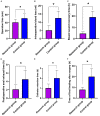Investigation of the application of Enhanced Recovery After Surgery (ERAS) in elderly patients undergoing surgery for kidney stones
- PMID: 38883383
- PMCID: PMC11170615
- DOI: 10.62347/QOAR2593
Investigation of the application of Enhanced Recovery After Surgery (ERAS) in elderly patients undergoing surgery for kidney stones
Abstract
Objective: To investigate the efficacy and application of Enhanced Recovery After Surgery (ERAS) in elderly patients undergoing surgery for kidney stones.
Methods: Clinical data of 104 elderly patients who underwent kidney stone surgery at West China Hospital, Sichuan University from January 2020 to December 2022 were retrospectively analyzed in this study. The patients were divided into two groups according to different nursing plans. Among them, 52 patients in the control group received conventional nursing, and 52 patients in the study group received ERAS mode nursing. Postoperative recovery, anxiety, complications, stress response and quality of life were compared between the two groups.
Results: The time to recovery of postoperative rehabilitation indices in the research group was significantly shorter compared to the control group (P < 0.05). The research group also exhibited a significantly lower incidence of complications such as hematuria, abdominal pain, vomiting, chills, fever, and hypotension (all P < 0.05). Before the initiation of nursing care, there were no significant differences in the State Anxiety Inventory (SAI) and Trait Anxiety Inventory (TAI) scores between the two groups (both P > 0.05). However, after nursing care, the research group exhibited lower SAI and TAI scores compared to the control group (all P < 0.05). Similarly, there was no significant difference in the General Quality of Life Inventory-74 (GQOLI-74) scores in any dimension between the two groups before nursing care (P > 0.05), but the research group showcased higher scores in every dimension after nursing care (P < 0.05). The levels of Heme Oxygenase-1 (HO-1), Endothelin-1 (ET-1), Adrenocorticotropic Hormone (ACTH), and Cortisol (Cor) were significantly lower in the research group after nursing care (all P < 0.05). The acknowledgment and approval scores of nursing care in the research group were higher than those in the control group (P < 0.05).
Conclusion: The application of ERAS in elderly patients with kidney stones undergoing transurethral ureteral holmium laser lithotripsy is efficacious in mitigating stress reactions, enhancing quality of life and reducing perioperative anxiety, minimizing the incidence of complications, and promoting overall patient recovery.
Keywords: Elderly; Enhanced Recovery After Surgery; kidney stone; nursing; surgery.
AJTR Copyright © 2024.
Conflict of interest statement
None.
Figures




Similar articles
-
Enhanced recovery after surgery continuity nursing in elderly gastric cancer patients.World J Gastrointest Surg. 2025 May 27;17(5):103340. doi: 10.4240/wjgs.v17.i5.103340. World J Gastrointest Surg. 2025. PMID: 40502482 Free PMC article.
-
Effectiveness of Enhanced Recovery After Surgery in the Perioperative Period for Patients with Ureteral Calculi.Altern Ther Health Med. 2023 Oct;29(7):354-359. Altern Ther Health Med. 2023. PMID: 37499155 Clinical Trial.
-
Optimizing surgical outcomes for elderly gallstone patients with a high body mass index using enhanced recovery after surgery protocol.World J Gastrointest Surg. 2023 Oct 27;15(10):2191-2200. doi: 10.4240/wjgs.v15.i10.2191. World J Gastrointest Surg. 2023. PMID: 37969721 Free PMC article.
-
Effect of Enhanced Recovery after Surgery (ERAS) Concept and Cluster Nursing on Psychological State and Pain of Oral Outpatients Undergoing Root Canal Therapy.Comput Math Methods Med. 2022 Sep 10;2022:4868569. doi: 10.1155/2022/4868569. eCollection 2022. Comput Math Methods Med. 2022. PMID: 36124168 Free PMC article.
-
The Safety and Feasibility of Enhanced Recovery after Surgery in Patients Undergoing Pancreaticoduodenectomy: An Updated Meta-Analysis.Biomed Res Int. 2020 May 8;2020:7401276. doi: 10.1155/2020/7401276. eCollection 2020. Biomed Res Int. 2020. PMID: 32462014 Free PMC article.
References
-
- Somani B, Seitz C. Editorial: future of kidney stone management. Curr Opin Urol. 2023;33:71–72. - PubMed
-
- Buckey JC, Thamer S, Lan M. Bone loss and kidney stone risk in weightlessness. Curr Opin Nephrol Hypertens. 2023;32:172–176. - PubMed
-
- Hoffman A, Braun MM, Khayat M. Kidney disease: kidney stones. FP Essent. 2021;509:33–38. - PubMed
-
- Galán-Llopis JA, Sánchez-Pellicer P, Navarro-López V. Role of microbiome in kidney stone disease. Curr Opin Urol. 2023;33:84–89. - PubMed
-
- Ferraro PM, Bargagli M. Dietetic and lifestyle recommendations for stone formers. Arch Esp Urol. 2021;74:112–122. - PubMed
LinkOut - more resources
Full Text Sources
